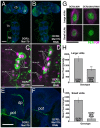RNA-interference knockdown of Drosophila pigment dispersing factor in neuronal subsets: the anatomical basis of a neuropeptide's circadian functions
- PMID: 20011537
- PMCID: PMC2788783
- DOI: 10.1371/journal.pone.0008298
RNA-interference knockdown of Drosophila pigment dispersing factor in neuronal subsets: the anatomical basis of a neuropeptide's circadian functions
Abstract
Background: In animals, neuropeptide signaling is an important component of circadian timekeeping. The neuropeptide pigment dispersing factor (PDF) is required for several aspects of circadian activity rhythms in Drosophila.
Methodology/principal findings: Here we investigate the anatomical basis for PDF's various circadian functions by targeted PDF RNA-interference in specific classes of Drosophila neuron. We demonstrate that PDF is required in the ventro-lateral neurons (vLNs) of the central brain and not in the abdominal ganglion for normal activity rhythms. Differential knockdown of PDF in the large or small vLNs indicates that PDF from the small vLNs is likely responsible for the maintenance of free-running activity rhythms and that PDF is not required in the large vLNs for normal behavior. PDF's role in setting the period of free-running activity rhythms and the proper timing of evening activity under light:dark cycles emanates from both subtypes of vLN, since PDF in either class of vLN was sufficient for these aspects of behavior.
Conclusions/significance: These results reveal the neuroanatomical basis PDF's various circadian functions and refine our understanding of the clock neuron circuitry of Drosophila.
Conflict of interest statement
Figures













Similar articles
-
The Drosophila Receptor Protein Tyrosine Phosphatase LAR Is Required for Development of Circadian Pacemaker Neuron Processes That Support Rhythmic Activity in Constant Darkness But Not during Light/Dark Cycles.J Neurosci. 2016 Mar 30;36(13):3860-70. doi: 10.1523/JNEUROSCI.4523-15.2016. J Neurosci. 2016. PMID: 27030770 Free PMC article.
-
Drosophila free-running rhythms require intercellular communication.PLoS Biol. 2003 Oct;1(1):E13. doi: 10.1371/journal.pbio.0000013. Epub 2003 Sep 15. PLoS Biol. 2003. PMID: 12975658 Free PMC article.
-
The neuropeptide PDF acts directly on evening pacemaker neurons to regulate multiple features of circadian behavior.PLoS Biol. 2009 Jul;7(7):e1000154. doi: 10.1371/journal.pbio.1000154. Epub 2009 Jul 21. PLoS Biol. 2009. PMID: 19621061 Free PMC article.
-
Circadian Rhythms and Sleep in Drosophila melanogaster.Genetics. 2017 Apr;205(4):1373-1397. doi: 10.1534/genetics.115.185157. Genetics. 2017. PMID: 28360128 Free PMC article. Review.
-
Downloading central clock information in Drosophila.Mol Neurobiol. 2002 Oct-Dec;26(2-3):217-33. doi: 10.1385/MN:26:2-3:217. Mol Neurobiol. 2002. PMID: 12428757 Review.
Cited by
-
Integration of Circadian Clock Information in the Drosophila Circadian Neuronal Network.J Biol Rhythms. 2021 Jun;36(3):203-220. doi: 10.1177/0748730421993953. Epub 2021 Mar 1. J Biol Rhythms. 2021. PMID: 33641476 Free PMC article. Review.
-
Pigment Dispersing Factor Is a Circadian Clock Output and Regulates Photoperiodic Response in the Linden Bug, Pyrrhocoris apterus.Front Physiol. 2022 Apr 29;13:884909. doi: 10.3389/fphys.2022.884909. eCollection 2022. Front Physiol. 2022. PMID: 35574487 Free PMC article.
-
Sites of Circadian Clock Neuron Plasticity Mediate Sensory Integration and Entrainment.Curr Biol. 2020 Jun 22;30(12):2225-2237.e5. doi: 10.1016/j.cub.2020.04.025. Epub 2020 May 7. Curr Biol. 2020. PMID: 32386535 Free PMC article.
-
Old flies have a robust central oscillator but weaker behavioral rhythms that can be improved by genetic and environmental manipulations.Aging Cell. 2012 Jun;11(3):428-38. doi: 10.1111/j.1474-9726.2012.00800.x. Epub 2012 Feb 24. Aging Cell. 2012. PMID: 22268765 Free PMC article.
-
E and M circadian pacemaker neurons use different PDF receptor signalosome components in drosophila.J Biol Rhythms. 2013 Aug;28(4):239-48. doi: 10.1177/0748730413497179. J Biol Rhythms. 2013. PMID: 23929551 Free PMC article.
References
-
- Dunlap JC. Molecular Bases for Circadian Clocks. Cell. 1999;96:271–290. - PubMed
-
- Herzog ED. Neurons and networks in daily rhythms. Nat Rev Neurosci. 2007;8:790–802. - PubMed
-
- Ralph M, Foster R, Davis F, Menaker M. Transplanted suprachiasmatic nucleus determines circadian period. Science. 1990;247:975–978. - PubMed
-
- Silver R, LeSauter J, Tresco PA, Lehman MN. A diffusible coupling signal from the transplanted suprachiasmatic nucleus controlling circadian locomotor rhythms. Nature. 1996;382:810–813. - PubMed
-
- Michel S, Geusz M, Zaritsky J, Block G. Circadian rhythm in membrane conductance expressed in isolated neurons. Science. 1993;259:239–241. - PubMed
Publication types
MeSH terms
Substances
Grants and funding
LinkOut - more resources
Full Text Sources
Molecular Biology Databases

